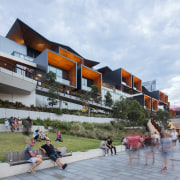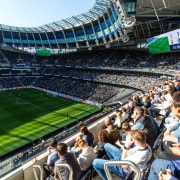Stadium of the future
Populous senior principals Chris Paterson and Tom Jones consider the key themes driving the nature of entertainment venues and fan experiences today
Major pieces of social infrastructure like convention centres and stadia are increasingly providing the platform to create or reignite the vibrancy and liveability of modern cities. As technology advances and demographic changes take place, architects need to be able to respond, providing facilities for both fans and the wider community to enjoy every week of the year, and for a range of different events without compromising their core function.
We also need to recognise that fans want far more than to just be spectators anymore, they want to be active participants in the event. This means that we need to start by designing experiences rather than just the location of a seat in a seating bowl in order to allow live events to compete with other leisure opportunities.
Venues of this scale also need to respond to the key challenges of sustainability and environmental design.
As the new Tottenham Hotspur stadium opens in London, we consider how this and many other major entertainment venues are bringing new experiences for the users, creating an active precinct for the community as well as additional revenue streams for venue operators.

Multi-purpose venues
The significant investment required for the construction of a stadium or arena means that it needs to maximise its operations and optimise its revenue generation. Venues are looking to find ways of transforming, inside and out, to host a range of different sports and other commercial activities.
The new stadium for Tottenham Hotspur has been designed to host both Premier League Football and American Football for the NFL, offering bespoke facilities that will help to service both forms of football. A double-height conference and banquet space has also been provided, which offers hospitality on a match day, but will drive a fully fledged conference business on non-match days.
This business is also supported by the construction of an adjacent hotel, which can host players and support staff for sporting events and delegates for business networking events. The provision of a market place and onsite micro-brewery linked to a new public square will also lead to a range of activation opportunities outside of match days.
Digital infrastructure
Some of the biggest advances in technology relate to the size and scale of digital infrastructure and the development of a digital network that supports and promotes new user experiences in and around the stadium.
The development of comprehensive mobile and Wi-Fi networks is starting to provide full connectivity for fans, which in turn will provide digital information guiding fans along the transport networks to the stadium and then circulating around the stadium itself.
Large-scale LED screens are increasingly being used on both the exterior façades of stadiums and inside the seating bowl to communicate with fans and provide opportunities for interactions through digital apps and touchscreen interfaces.
LED boards now wrap around the perimeter of the pitch and around various levels of the stadium and allow the possibility to vary the look and feel within the stadium through digital displays. External façades can also be animated with programmable LED lighting and effects that can be fully coordinated with match-day presentation within the seating bowl to create an integrated visual environment.
Interactive fan experience
A combination of advances in digital technology and the move for architects to design stadia and arenas within a comprehensive BIM environment means that a whole new range of opportunities are being opened up to enable fans to interact with venues in more ways than just the traditional physical visit to the building.
Tottenham Hotspur has utilised a full range of virtual and augmented reality as part of their engagement with fans at the new stadium. Hospitality sales have been driven out of a VR sales suite, rather than the more traditional mock-up of a hospitality box, with interactive 3D walk-throughs and augmented reality also utilised to enable customers to get a much more realistic perspective of the new stadium before they buy their tickets.
They have also recently launched their general admission sales with a digital platform that allows fans to explore each individual seat in an online 360-degree bowl environment, which provides interactive seat views on their mobile phones.

Rethinking the playing field
Having the ability to provide different playing surfaces within a stadium opens up a much wider range of possibilities for hosting sports and entertainment events and developing a transformable venue.
This was a key factor for Tottenham Hotspur in developing their innovative moving pitch that provides a natural grass surface for Premier League Football and artificial grass for American Football.
Significant investment in modelling and prototyping the fully automated pitch trays was undertaken to ensure that the dynamic performance of the playing surface and behaviour of the joint between moving sections of the pitch was fully understood and compatible with the sport, ahead of construction.
The speed of changeover provided by the automated system was also a key concern in being able to offer optimum flexibility in event planning and transitions between sports and surfaces, which will open up new options for promoters in scheduling events.
Automated amenities
As part of the technological revolution in society, people are becoming increasingly reliant on their smartphones to direct, organise and even pay for purchases. Digital apps are now commonplace and the role of cash in transactions is steadily reducing, as younger generations grow up without an understanding of how a cheque, notes or coins would be used in a transaction.
Tottenham Hotspur have taken the bold decision to make their new stadium a completely cashless venue, which will require fans to pay for food and drink and other retail purchases with a digital device.
This opens up opportunities for varying the commercial offers within the stadium during an event and for fans receiving information and offers during a match that can be linked to the outcome of a game or future event. Digital signage in retail areas and around concessions can also be linked to the same digital platform and adjust pricing and offers according to the commercial environment.

Connecting the venue
One of the big advances in the design and planning of stadia and arenas has been to see how they can be fully integrated into urban environments and move away from being standalone object buildings that only come to life on a match day.
Joint venture partners, Hassell + Populous designed Sydney’s international convention, exhibition and entertainment precinct at Darling Harbour. The precinct reflects the dynamism of Sydney’s cityscape, redefining Darling Harbour, while respecting the precinct’s parkland setting.
One of the most important features of ICC Sydney is that it provides more public open space than was there before, a better space with greater amenity for everyone. It is about being open, welcoming and enjoying what makes Sydney a truly global and unique city.
Story by: Populous
Home kitchen bathroom commercial design
At one with the Amazon
Contrast and connection
Simplified seclusion
Commercial Design Trends Vol. 35/1C
A new commercial office building can sometimes be more than just a place to work – it can also be an integral component ...
Read More















